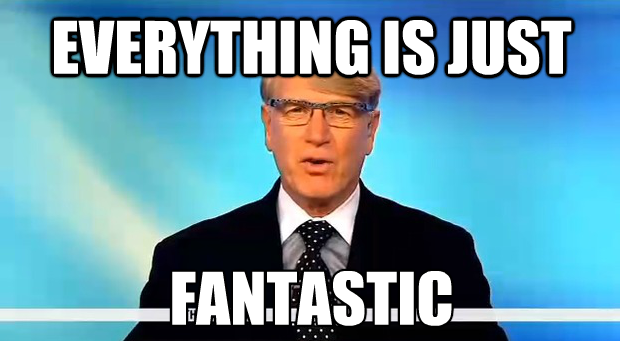ND University System Tries To Explain Away Explosion In Funding

Back in April I wrote about the North Dakota University System starting a new blog – called “Extra Credit” – which, according to them, seeks to correct misconceptions about facts perpetrated by their critics.
It’s pretty clear that the blog is aimed at me, which I take as a compliment to my work on higher education as an issue and Say Anything’s reach as a venue for serious reporting. Seriously, guys, I’m flattered.
Their first post sought to address a graph I’m fond of posting which illustrates administrative bloat in the university system by comparing the number of instructional positions at the universities (people actually engaged in teaching students) with the number of non-instructional employees. Here’s a spoiler: One of those categories has grown a lot faster than the other.
Their latest post now seeks an “apples to apples” comparison for state higher education spending. “Critics of increased funding for higher education in North Dakota are fond of adding numbers together and creating charts that create false pictures of where money is going and then declaring, ‘These are the facts,” the post begins. “The truth is these exaggerated visuals are not the facts because critics are not comparing apples to apples.”
The chart I’m assuming the university propagandists are referring to is this one with correlates legislative appropriations to higher education with enrollment growth. As you can see, one line indicates rapid growth in spending while the other indicates rather flat growth in enrollment.
What’s ironic is that I didn’t actually create this chart. It was created by Legislative Council and included in their Budget and Fiscal Trends report to lawmakers. So, it’s a little hard to argue that this is an “exaggerated visual” created by someone hoping to mislead the public about higher education spending.
The university system rebuts this image with one of their own, which doesn’t including the enrollment numbers (I don’t think there’s any way for them to get around the fact that we’re spending a lot more tax dollars to educate not that many more students) and attempts to blunt the image of that sharp increase in spending by separating so-called “one time spending” from baseline budget spending.
At the end of the post, the higher ed folks provide another of their snarky “true false” tests to sum up the point they’re trying to make (at the bottom of the first post they made a crack about my criticism of the university system flying their bureaucrats around in private airplanes):
There are problems with this argument.
First, are we supposed to pretend as though one-time spending on building projects doesn’t create on-going spending obligations? Are we to believe that these new buildings are maintenance free? That they will never need repairs or refurbishment? That there aren’t implications for insurance costs? Heating? Cooling? Electricity? Staffing? The bigger our campuses get – and it often seems as though the mission of the university system isn’t so much educating students as building campus empires – the more expensive they are for the public.
Second, whether we’re talking about one-time spending or “base funding,” it’s all the same tax dollars. Such distinctions mean very little to taxpayers when the budget for the university system increases year after year. It doesn’t matter how much this biennium’s $900 million higher education budget was “one time” if next biennium’s budget is over $1 billion.
Third, where is the evidence that all this spending is producing better outcomes for students in the university system? Keep in mind that while taxpayers have seen a dramatic increase in of the university system to them, the students have seen a big increases in their tuition as well. If enrollment is growing much more slowly than spending (it is), if tuition is growing about as fast as taxpayer appropriations (it is) then what are we accomplishing? Better academic outcomes? Not really. Graduation rates and other measures education achievement are about as mediocre as they’ve been for the last decade.
It seems what we’re mostly accomplishing is payroll bloat on ever-expanding campuses. Which might be great for university system bureaucrats, but isn’t so great for taxpayers or students.







